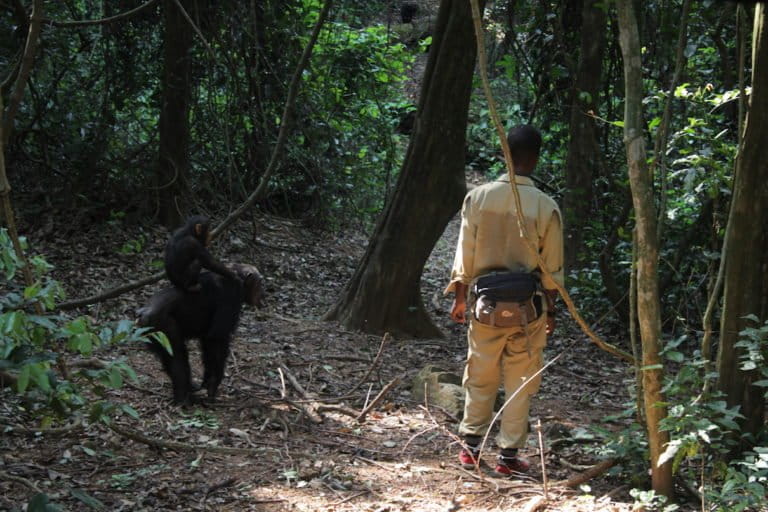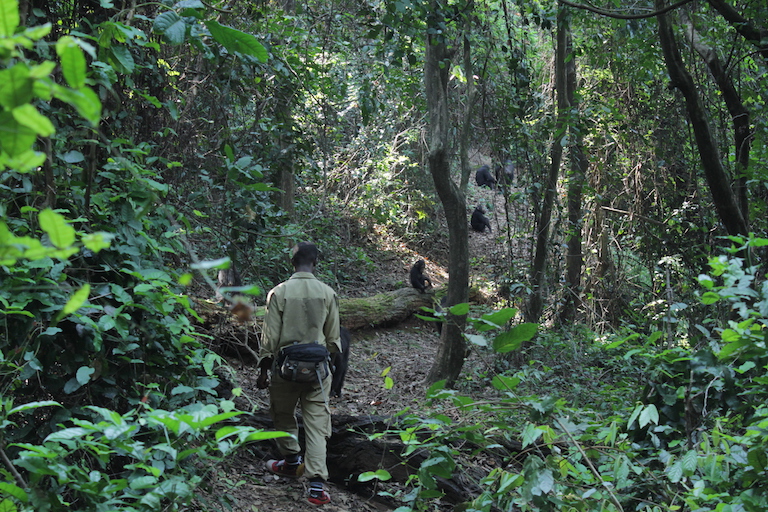- The chimpanzee population in Gombe National Park in Tanzania has declined significantly in recent years.
- Among other factors, loss of suitable habitats due to charcoal production and smallholder agriculture has contributed to this drop.
- The Jane Goodall Institute, domiciled in Gombe, is now working with the communities living near the park to address these issues.
GOMBE, Tanzania — On the eastern shores of Lake Tanganyika, 16 kilometers (10 miles) north of the town of Kigoma in Tanzania, lies the green, dense forest of Gombe National Park. Made famous by British primatologist Jane Goodall’s decades-long research on the park’s resident chimpanzees, Gombe, at 52 square kilometers (20 square miles), is among the smallest parks in Tanzania.
The park doesn’t have a perimeter fence surrounding it. This has allowed chimpanzees to move in and out freely, following age-old forest corridors that connect their core habitats. Since the late 1990s, many of these corridors have, however, been cleared for charcoal, timber, settlements and farming, which has resulted in increased human-chimpanzee conflict and declining chimpanzee numbers.
Until the early 1970s, Gombe, upgraded to a national park from a game reserve in 1968, boasted a population of between 150 and 160 chimpanzees (Pan troglodytes). Today, chimpanzee numbers in the park are down to about 95, according to Andrew Collins, director of baboon research at the Gombe Stream Research Centre, part of the Jane Goodall Institute.
Tanzania’s remaining chimpanzee populations are also in trouble. The country has about 2,500 of the great apes, most of them the eastern chimpanzee subspecies (P.t. schweinfurthii). Of these, more than 1,000 chimpanzees are found outside formally protected areas and face imminent dangers due to the conversion of suitable habitats to farmland and human settlements.

Threats from smallholder agriculture
Evidence of destruction of forests in the Kigoma region, where Gombe sits, is everywhere. The road from Kigoma town to Kakonko district is lined with sacks of charcoal, neatly stacked for sale to passing travelers. Forests have also been cleared on either side of the road to make way for farming. Cassava is a popular crop, and oil palms dot every parcel of land. Palm oil is sold at every shopping center, with a 1.5-liter (3.1-pint) bottle going for 5,000 Tanzanian shillings ($2).
In fact, smallholder agriculture is likely the single most vicious threat to chimpanzees in Tanzania, according to the Tanzania Chimpanzee Conservation Action Plan 2018-2023, a joint strategy between governmental and nongovernmental organizations to protect the country’s eastern chimpanzees.
One of the main contributors to the reduction of chimpanzee habitats is the growing popularity of the African oil palm (Elaeis guineensis) in western Tanzania. The Kigoma region in particular is known for smallholder oil palm cultivation, with farmers sending more than 150,000 liters (40,000 gallons) of palm oil annually to local refineries. Villagers living around Gombe cultivate the palm tree among other crops. Homesteads on the outskirts of Kigoma town are obscured by towering palm trees.
The demand for palm oil could grow even bigger as the country aims for self-sufficiency in edible oils. In June 2018, the government of Tanzania slapped a higher tax on imported edible and refined cooking oils, in a bid stimulate domestic production. Recent research by the Tanzania Private Sector Foundation, as reported by Food Business Africa, found that Tanzania’s annual production of 180,000 tonnes of edible oil only covers about one-third of local demand. By 2030, the foundation estimates that demand could rise to 700,000 tonnes. Upping domestic production means clearing more farmland for oil palm cultivation, and therefore further destruction of suitable habitats for chimpanzees.

Migration leads to increased chimp-human contact
Those habitats are in many cases linked by forest corridors with sufficient food, that allow chimpanzees to move freely without human interference. But expanding farmlands have degraded these critical chimpanzee lifelines. Corridors connecting Gombe National Park to the rural wards of Kazuramimba and Ilagala are in especially poor condition, according to the national chimpanzee action plan. Chimpanzees moving out of Gombe into these corridors frequently encounter human settlements or people engaged in farming or charcoal burning, resulting in conflict.
“I can recall about three chimpanzees that went into the villages and were killed,” Deus Mjungu, director of chimpanzee research at the Gombe Stream Research Centre, told Mongabay. “Two of them were in 1998, and one, an adult male, was killed in 2001. More recently, though, healthy chimpanzees have left the forest and were seen again.”
There are also some 1,200 chimpanzees living outside Gombe, Collins said. Some of these chimpanzee families live close to Gombe, near the village of Mwamgongo, for instance, about 6 kilometers (4 miles) from the park’s northern border. Other chimp families can be found as far as the eastern border of Mpanda district, more than 250 kilometers (155 miles) away.
Chimpanzees that live inside Gombe sometimes leave the park to find a new family outside. Female chimps may leave their community to join other communities upon reaching reproductive age. They also move out of the park to look for food, which can be scarce during the dry season, Collins said.
It’s during such migrations that healthy chimpanzees from Gombe may be hunted and killed, Collins added.

With forests being cleared for human settlements, chimpanzees end up eating what they can find, and this includes crops on farms. This in turn results in conflict with farmers trying to protect their crops.
Human migration into chimpanzee habitats has also had an impact. Just across Lake Tanganyika, which marks Gombe’s western boundary, is the Democratic Republic of Congo, and a few kilometers north lies Burundi. Both countries have experienced violent upheavals in the recent past, causing some 300,000 people to seek refuge in northern Tanzania. This influx of refugees, many of them put up in rural areas in Kigoma, has put further pressure on chimpanzee habitat due to the demand for building material, firewood and charcoal.
There’s also the threat of bushmeat hunting. Provided with meager rations, refugees in Tanzania have been known to hunt wild game, including endangered species, to supplement their diets. Neither Tanzanians nor Burundians have traditionally eaten apes, Mjungu said, but many Congolese ethnic groups do. While no incidents of bushmeat hunting have been reported in the greater Gombe ecosystem, chimpanzees continue to disappear, Mjungu said. He added he couldn’t rule out the possibility that bushmeat hunting was taking place.

Working toward a peaceful coexistence
To encourage peaceful coexistence between the people living next to the park and the chimpanzees, the Jane Goodall Institute has embarked on a number of initiatives. It worked with local communities to create a land use plan for their villages, for instance. The researchers began by using satellite imagery to map the area. Then, armed with printouts of the area maps, they canvassed the villages to ask residents for their input. From these discussions, villagers identified areas used for settlements, land for grazing their livestock, and water catchment areas.
“Just by sitting with them and sharing with them on those maps … we drew their attention and slowly discussed on how we could harmoniously use the area,” Mjungu said.
The resulting land-use plan eventually led to an agreement between the park and people living in surrounding villages in which the latter set aside an area of their village land for conservation. These village forest reserves include forest, water catchment areas and riverbanks, and act as suitable habitats and corridors for chimpanzees. Most of them occur along the borders of the park and along chimpanzee corridors, Collins said, to ensure that chimpanzees feed and move freely.
Of the more than 100 villages surrounding Gombe, around 70 have set aside such village reserves. According to Mjungu the project has been successful except for a few instances where some people have started unsustainably harvesting the trees within their village reserves, flouting the agreement. Since the reserves lie in the villages and not inside the park, neither the park authorities nor the Gombe Stream Research Centre have much authority over them.
To bring about change, the Gombe Stream Research Centre is helping create awareness among schoolchildren about the importance of protecting the environment. Students, for example, have grown seedlings at school and transplanted them back in their homes under the village reserve program.
“It is more effective when children are the ones telling the parents that ‘we need to plant more trees to protect the environment’ than when it is coming from somebody else,” said Jumanne Kikwale, a resident of Mwamgongo village, north of Gombe National Park, who also works at the Gombe Stream Research Centre. “This is what happened and the message was received well.”

Banner image: A chimpanzee inside Gombe National Park, by Anthony Langat for Mongabay.
Editor’s note: Jane Goodall is a member of Mongabay’s advisory board.
FEEDBACK: Use this form to send a message to the author of this post. If you want to post a public comment, you can do that at the bottom of the page.
